| 来源类型 | Research Reports
|
| 规范类型 | 报告
|
| DOI | https://doi.org/10.7249/RR1051
|
| ISBN | 9780833089106
|
| 来源ID | RR-1051-OSD
|
| Air Defense Options for Taiwan: An Assessment of Relative Costs and Operational Benefits |
| Michael J. Lostumbo; David R. Frelinger; James Williams; Barry Wilson
|
| 发表日期 | 2016
|
| 出版年 | 2016
|
| 页码 | 84
|
| 语种 | 英语
|
| 结论 |
People's Liberation Army (PLA) Capabilities Force Taiwan to Substantially Rethink and Restructure Its Air Defense Because Taiwan's Fighter Force Faces a Trio of Problems- Taiwan's fighter force is vulnerable to missile attack while on the ground.
- It is outnumbered in the air.
- It is less capable in the air than the latest PLA aircraft.
Surface-to-Air Missiles' Survivability Makes Them a Preferred Option- Multilayered surface-to-air missiles (SAMs) can become an important contributor to Taiwan's defense as enablers of other defensive operations but not to defend fixed targets.
- They are a difficult capability for China to counter easily.
Taiwan Needs More-Mobile and Shorter-Range Air Defense Systems- Taiwan's existing Patriot and TK forces provide relatively long-range capabilities that need to be complemented with a shorter-range, more-survivable system.
Taiwan Can Afford New SAM Investments If It Divests Some of Its Existing Fighter Aircraft Fleet- SAMs are affordable within current budget levels if Taiwan divests some of its existing fighter force.
|
| 摘要 |
- To continue to provide a credible deterrent and be seen as having the potential to contest its own airspace, Taiwan needs to invest in and invigorate its SAM force. These should get priority over fighters.
- As Taiwan assesses its future air defense needs, it should devote most of its air defense resources to investment in its surface-to-air missile (SAM) force. In sizing that force, it should be able to meet the demands on the SAM forces to support maneuver forces in an invasion scenario but also have the capacity to meet some air defense demands in a coercive scenario, which could be a prelude to a larger conflict and thus places an additive demand on the SAM force. Taiwan's fighter force is limited to a supporting role in coercive scenarios involving very low levels of force. In sizing the force, Taiwan should first consider the demand for SAMs.
- A shorter-range system that could provide a more cost-effective layered air defense should complement current Patriot/TK III systems. A new air defense system could engage aircraft and cruise missiles using ground-launched air-to-air missiles. Such a system could rapidly engage many targets, have a deep magazine, and be built around lower-cost radars networked together that allow them to effectively engage many targets in a short amount of time.
|
| 主题 | Air Defense
; Military Force Planning
; Taiwan
|
| URL | https://www.rand.org/pubs/research_reports/RR1051.html
|
| 来源智库 | RAND Corporation (United States)
|
| 引用统计 |
|
| 资源类型 | 智库出版物
|
| 条目标识符 | http://119.78.100.153/handle/2XGU8XDN/108275
|
推荐引用方式
GB/T 7714 |
Michael J. Lostumbo,David R. Frelinger,James Williams,et al. Air Defense Options for Taiwan: An Assessment of Relative Costs and Operational Benefits. 2016.
|
|
文件名:
|
x1495316251135.jpg
|
|
格式:
|
JPEG
|

|
文件名:
|
RAND_RR1051.pdf
|
|
格式:
|
Adobe PDF
|
除非特别说明,本系统中所有内容都受版权保护,并保留所有权利。